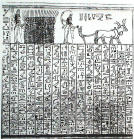It is over five millennia since man first began writing messages to his compatriots concerning food and trade tallies. Originally in clay, these inscriptions progressed over the centuries to descriptions of battles and royal personages and were carved in stone to portray their strength and to serve as a permanent reminder of their importance.
In the following millennia methods were discovered for writing onto papyrus and materials such as linen, in order that messages could be carried from place to place. Pictograms gave way to modern alphabets which encouraged the art of calligraphy, as well as making scribes an important part of the community. In particular religious texts were copied by monks who may have spent their entire lives in this pursuit, producing the beautiful illustrated texts we now see mainly on Christmas cards.
In the 15th century Johannes Gutenberg began producing bibles and other printed matter on his moveable type press which meant multiple copies were available for the first time.This allowed for the dissemination of knowledge and ideas which have slowly spread worldwide.
Until relatively recently books maintained the same format as those of the 17th century. The printed text had a static quality and books with their binding and covers exuded a feeling of permanence. They were stacked on shelves and merged into the background like bricks in a wall.


